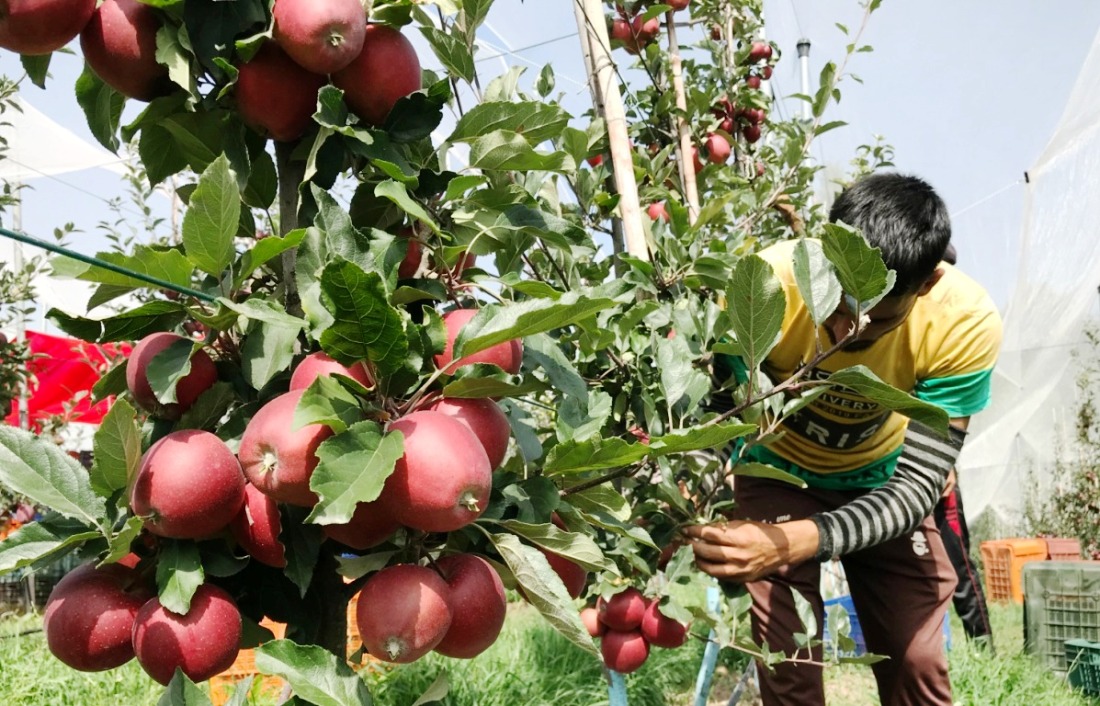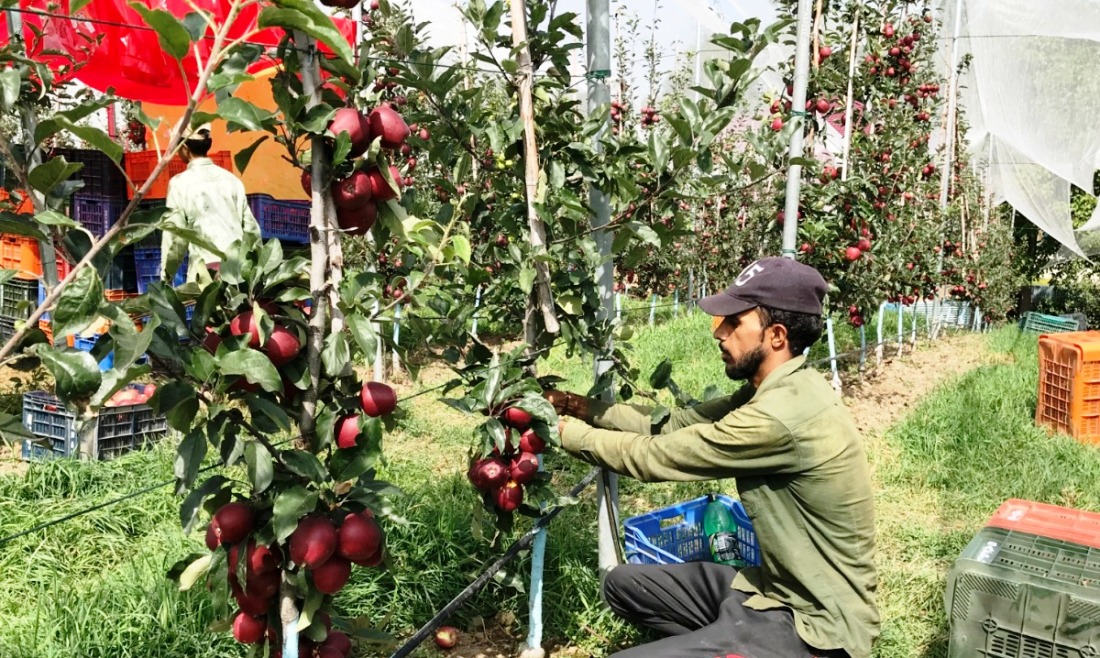For the first time in many years, Kashmir is expected to consume a record number of high-density plants this fall. The driving force is the visible snowballing effect of the modern orchards scattered across Kashmir that emerged as demonstration plantations for the people, reports Masood Hussain
These days, growers who have successfully cultivated high-density apple orchards are excited. Though only a fraction of the vast swathes of land under apple has been converted from traditional to high-yielding imported varieties, the massive appetite that the market is exhibiting is expected to make the high-density apple hugely popular.
“The demand is an outcome of the crisis in Himachal Pradesh that suffered serious floods,” Shahnawaz Khan, one of the apple growers in Shopian’s Pinjoora village said. “In August-September, it was the Himachal apple that would dominate the market but because of floods that damaged the roads, it is not able to keep the supply intact and manage the demand.”
This demand, Khan said, has appreciated the value to a historic high but is unlikely to remain the same in future. “That does not mean the high density will not pay well. It has paid well and it will continue doing so,” he explained. “But growers should not expect that it will always fetch the same value.”
However, the massive appetite that the market is exhibiting right now for colourful, tasty and crunchy Kashmir apples has triggered a wave in favour of the high-density apple orchards at the grassroots. Mainly imported from Italy, this sensitive rootstock offers a uniform-sized, colourful fruit with a better yield in comparison to the traditional varieties and rootstock that will be ready for harvest in around three to four fortnights by now.
Better Year Ahead
“Unlike last year, we have much better pre-booking for this season,” an executive of a high-density orchard-making company, which pioneered the concept, said. “If my estimation is correct, right now, there are more than 20,000 kanals (nearly 20 kanals make a hectare) of high-density orchards of which more than 15000 kanals were done by us. This year is expected to be a huge year.”
Initially, the company had laid an orchard in scattered belts. Now every single one of these orchards has convinced 10 more to approach them for orchard conversion. “People have understood the significance of the high density as the initial orchards we laid emerged as the demonstration plots convincing people that they have to change,” he said. “Disruptive interventions take time and the moment seemingly has finally come.”
Right now, there are four active players in high-density apple orchard-making, who are approved by the government. They are empanelled under the subsidy scheme that the government has conceived. “We earlier had nine and then the number fell to two and now we have four players,” an officer in the horticulture department said. “Almost all are doing better and then a lot of people are not availing the subsidy scheme and making orchards by funding all the costs from their own savings.”
Talking about, what he termed, “the snowballing effect”, a key player said the 2023 fall will be phenomenal as far as high-density plantations are concerned. “Ever since we started the high-density plantation, we have used an estimated 30.5 lakh high-density plants,” he said. “Last year, Kashmir’s requirement was around five lakh plants and this year, we anticipated Kashmir may require nearly 10 lakh plants or even more.”

Another top officer in the horticulture department said they have “completely smoothened” the system and grower responses are better and encouraging. “So far, 552 hectares have been converted into high-density orchards and this is the figure that has been certified after joint inspection,” the officer said. “We have another 272 hectares of high-density plantations that are awaiting a survey, which means more than 800 hectares have been converted into high-density plantations already.”
The officer said their survey has revealed that besides the sponsored scheme, the people have done a lot on their own. “Our estimation is that around 1500 hectares have been converted into high-density plantations by the growers on their own without any subsidy,” the officer said. “Despite all this the achievement so far is just a decimal of the overall work that is to be done. Kashmir has 340 thousand hectares of land under traditional low-density plantations with aged varieties and converting even ten per cent of it into high-density plantations will take time.”
A Key Deficit
With the high density getting popular, an expectation was that the players would eventually invest in nurseries back home. This would reduce the cost of the plant which usually costs Rs 300 plus.
“We still get the planting material from Italy,” one player said. “In Kashmir, we lack the state of technology and processes that will help us have the high-density nurseries here. The process has started but it will take time.”
Right now, the planting material is a pre-grafted tree that is kept in quarantine for a year or more, once it reaches Kashmir, and then is shifted for trans-plantation in new orchards. “Experimentation for the multiplication of the rootstock is also in progress and will take some more time. Once the rootstock is ready, it will be transferred to a tree nursery on an experimental basis and eventually to the farmer’s orchard,” the market insider said. “In Europe, they have very high standards at the nursery level, something we may have to clone on a long-term basis but it is very capital intensive.”
Satisfied Growers
Apple growers who opted for the high-density orchards are happy. “When I availed the scheme in 2016 and axed an almost 80-year-old orchard to pave the way for high-density plantation, the tensions were there,” Danish Malik, a very well-read grower in south Kashmir said. “Now, I am happy. Initially, for two years, it required a lot of care but the maintenance level has fairly reduced. I am getting a uniform-sized, better-coloured crop and there is no change in the yield. It is actually increasing as the plantation is maturing. I regret that I should have thinned out part of the crop initially to help the tree.”
Malik said the conversion helped him in other ways as well. “It is ready for harvesting almost two months ahead when there is not much of the fresh fruit available in the market and the labour is abundant,” Malik said. “By the time we harvest and sell, the traditional varieties have started ripening and there is a labour shortage and fear of an early snowfall. The entire crop drives to the market and there is glut which impacts the yield.”
Some of the varieties in high-density plantations are disease-resistant and require less pesticide but “there are no compromises”. In traditional varieties, he said, most of the pesticide sprayed goes to waste because the trees are huge and tall, unlike the traditional varieties. Besides, there is no possibility of using hail-net in the traditional orchards. Usually, the high-density plantations require pesticide fog rather than a spray, experts believe.
Resisting Change
Open to nursery growers and orchard owners, the government offers a fifty per cent subsidy for high-density plantations. Against a requirement of an estimated Rs 2 lakh per kanal, the government funds half as the banking sector, especially Jammu and Kashmir Bank, has a debt funding scheme to cover most of the rest of the cost.
Officials said they have released a subsidy amount of Rs 62.52 crore after the joint inspection teams certified the plantations. This is against the allocated funds of Rs 82.96 crore.

However, the scheme has not been very popular. “The scheme was immensely popular in areas where the people had vacant land and they started laying high-density orchards,” Malik said. “People in very rare cases axed the traditional orchards to pave the way for planting the high-density trees.”
This has a specific reason. Most of the peripheral households have converted the rice fields into apple orchards in the last 30 years and now these orchards have become the main source of their income. “If I cut my orchards and decide to replace the planting material, it invariably would require three years,” Khazir Mohammad, who owns a 6-kanal orchard of low-density, traditional variety, said. “For three years, how can I run my routine and hearth?”
Experts believe that a brand-new high-density apple orchard does require at least two years to come to fruition. “Usually, it is the third year when the crop can be expected,” one expert said. While the scheme funds the plantation, the growers find it difficult to manage the costs required during the gestation period.
A Way Out?
Economics apart, a huge population of growers is so emotionally attached to the traditional orchards that axing them is not an option. There have been generational conflicts in the families where the elders are resisting the change merely for emotional reasons.
For some of them, a new experiment is coming to the rescue. A number of progressive apple growers in the Kashmir periphery, mostly in the south, have visited various places where better-yielding varieties are in vogue. They did a lot of experimentation to take a definite route. One of them is Shahnawaz Khan, who has successfully grafted high-yielding and better colour varieties in his low-density orchard having traditional rootstocks.
“When I started experimenting in my own orchards, people started thinking that I have lost my mental balance,” Khan said. “I did fail but I succeeded in top grafting the traditional trees and they also produce the best of the new varieties within the same time frame. I have used the M9 variety and for me, it is a success.”
Khan’s experimentation has led him to become an entrepreneur. He sells the grafting sticks to the willing farmers who do not want to axe their orchards. “For top grafting, I think it costs around Rs 500 a tree,” he said. “It takes two years and in the third year, the yield is better and the problems of colour and size are addressed.” He said he even succeeded in getting the best crop from a tree that is more than half a century old using the top grafting technique, which is also prevalent in Himachal Pradesh.
Yield and colour apart, it is not immediately known if using grafts from high-density varieties in low-density rootstock has any short-term or long-term consequences. Some experts do have reservations that it could lead to the transmission of diseases from traditional varieties to high-yielding varieties.















